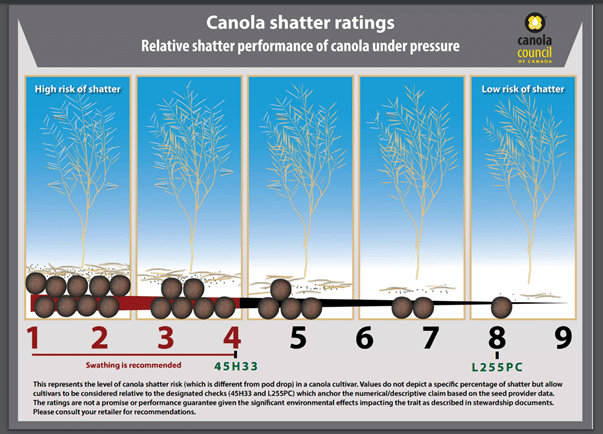Patience maximizes yield at swathing
As mid-August approaches, many growers may be getting anxious to start swathing. Wherever possible (and even if Twitter shows that neighbours near and far have begun), time swathing on crop stage rather than calendar date, even on shatter-prone cultivars. Research shows that delaying swathing from 30% to 60% seed colour change will produce about 10% more yield, or an extra $100/ac based on $20/bu canola and a 50bu/ac crop. Given that the cost of going from #1 to #2 grade for green seed is currently $8/tonne ($0.18/bu or $9.00/ac on a 50bu crop), the economics favour leaving the crop stand. Sun scald can make a crop look more mature than it actually is.
The new shatter rating system can help producers make more informed decisions about swathing versus straight cutting as well as timing and order. Ask your seed supplier for information on ratings for their cultivars. (Canola pod shatter rating)

Late season insect update
Diamondback moth larvae, bertha armyworms, grasshoppers and lygus bugs are appearing sporadically across the Prairies. Few fields currently exceed economic thresholds, except in the Peace and west-central Alberta where lygus bugs are at normal to high levels, and in central Alberta where some fields are being sprayed for diamondback moths and/or grasshoppers. Only spray if pest numbers meet or exceed economic thresholds.
Lygus thresholds: The updated threshold for lygus is 20-30 insects/10 sweeps. That said, some experienced consultants operating along Alberta’s Hwy 2 corridor where lygus are very common recommend waiting to spray until 50-80 insects/10 sweeps. Counts of 10 insects or below may actually increase yield. (Proper sweep net technique) (Lygus bugs scouting, timing and thresholds) (Prairie Pest Monitoring Network Weekly Update – August 5) (Insect scouting guide)
Disease scout now
With harvest nearing, scout weekly for disease: pull plants and check roots for clubroot and root rots, cut into the plant crown to look for blackleg, analyze whole plants for sclerotinia stem rot and other diseases. Find out what’s new and what proved effective this year by walking local trial plots and attending field days. Information about Provincial disease monitoring programs and free disease testing services is available here. (Why and how to scout before harvest) (Canola disease scouting) (Grower submitted canola samples support collective efforts to manage blackleg)
Spray to swath timing matters
To protect a crop’s marketability, take a few moments to carefully assess each insecticide and fungicide’s spray to swath interval – the number of days that must pass between a pesticide application and swathing or straight cutting – before applying this late in the season. Keep it Clean’s spray to swath calculator is an excellent tool to help choose products and confirm preharvest intervals. Simply enter the intended product and crop type into the calculator to calculate how long to wait after spraying, or enter the intended application timing and crop harvest date to generate a list of acceptable product options. (Pre-harvest tips and tools webinar)
